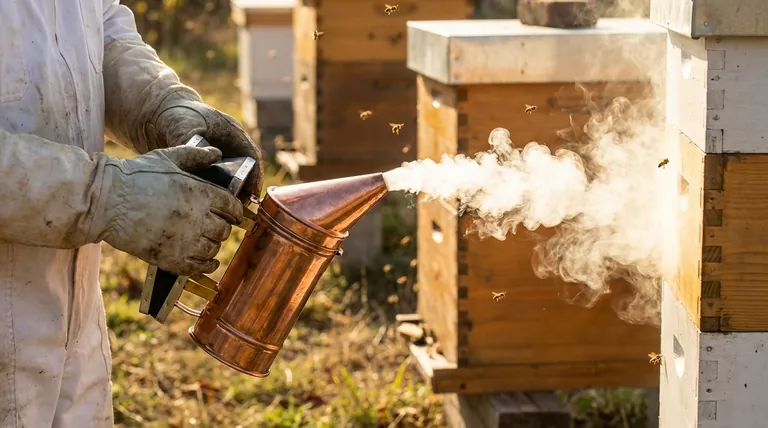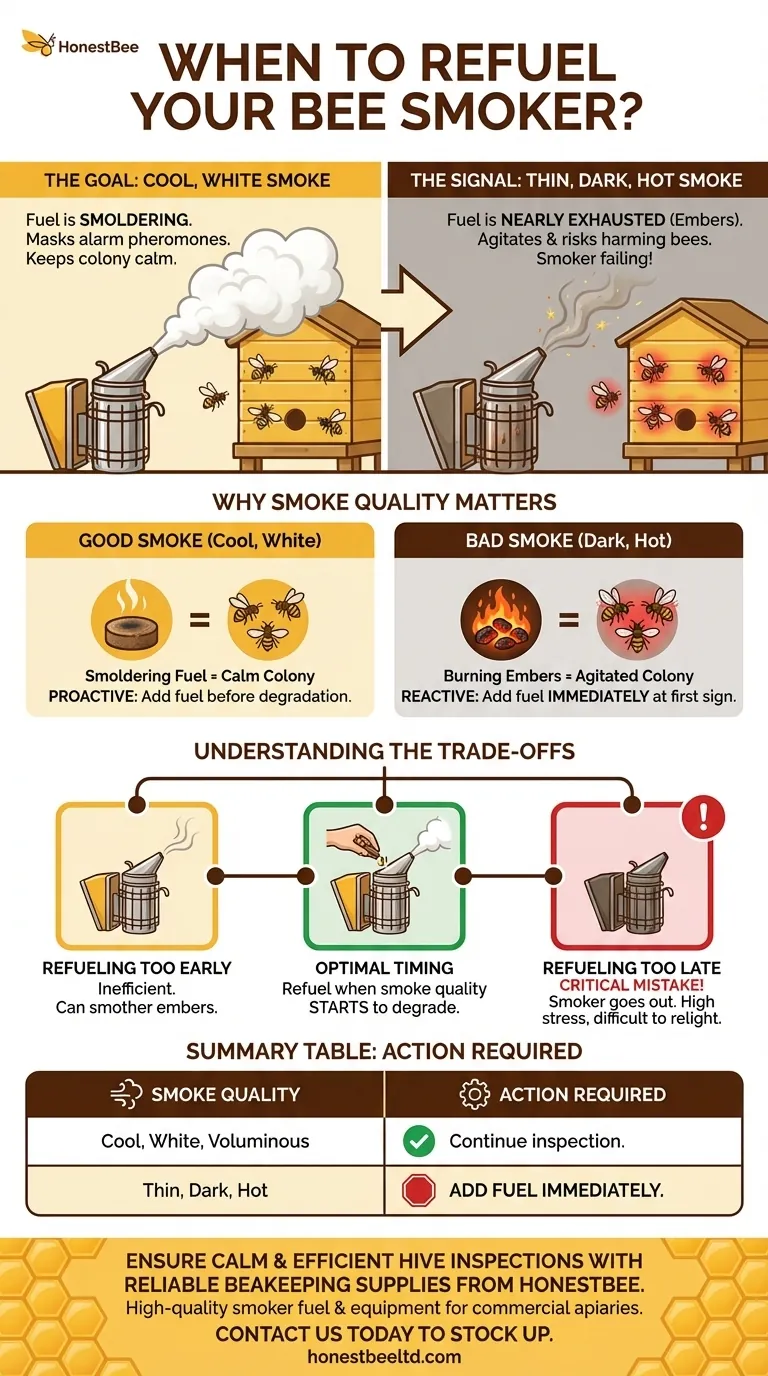The single most reliable indicator for refueling your bee smoker is a change in the smoke's quality. You should add more fuel the moment you notice the smoke becoming thin, dark, or hot. This is a critical signal that your fuel is nearly exhausted and the smoker is about to fail at its primary purpose of calming the colony.
The goal is to maintain a continuous supply of cool, white smoke, not just any smoke. Dark, acrid smoke indicates your fuel has burned down to embers, which can agitate rather than soothe your bees and even harm them.
Why Smoke Quality is Your Most Important Cue
The effectiveness of a smoker is entirely dependent on the type of smoke it produces. Understanding the difference between good and bad smoke is key to successful hive management.
What Cool, White Smoke Achieves
Cool, white, and voluminous smoke is generated when your fuel is smoldering, not actively burning. This type of smoke effectively masks the bees' alarm pheromones, preventing a colony-wide defensive response. It also encourages them to gorge on honey, making them more docile.
The Problem with Dark, Hot Smoke
Dark, hot, and thin smoke is a sign that your primary fuel has been consumed. You are now essentially just burning hot embers. This acrid smoke can be an irritant to the bees, potentially making them more aggressive. More importantly, it signals your smoker is moments away from going out completely.
The Visual Cue to Refuel
Watch for the shift. When the smoke coming from the nozzle changes from a thick, pleasant white to a wispy, grayish, or dark puff, it's time to act. This change indicates there is no longer enough fuel to smolder properly.
Understanding the Trade-offs of Smoker Management
Timing is everything. Both acting too late and, to a lesser extent, acting too early have consequences during a hive inspection.
The Inefficiency of Refueling Too Early
Adding more fuel to a smoker that is already full and burning well is not a major issue, but it can be inefficient. Piling on too much fresh fuel at once can sometimes smother the embers and temporarily weaken the smoke output.
The Critical Mistake of Refueling Too Late
This is the most common pitfall. If your smoker goes out mid-inspection, you lose your most important tool for keeping the colony calm. Attempting to relight a smoker while managing open frames and thousands of bees is difficult and stressful for both you and the colony.
The Danger of Hot Embers
Using a smoker that is only burning embers not only produces irritating smoke but also risks blowing hot ash or sparks into the hive. These embers can injure the bees, damage their delicate wings, or even harm the queen.
Making the Right Choice for Your Goal
A proactive approach to smoker fuel management ensures your inspections are calm and productive from start to finish.
- If your primary focus is a quick hive check: Pack your smoker well and ensure it is producing dense, white smoke before you open the hive. It should last for a brief inspection without issue.
- If your primary focus is a long inspection or honey harvest: Always keep extra fuel within arm's reach. Add a small handful of fuel as soon as you notice the smoke quality beginning to degrade, rather than waiting for it to become a problem.
- If your smoker produces dark smoke mid-inspection: Do not hesitate. Immediately add more fuel and use a few gentle puffs from the bellows to encourage the new material to smolder and restore the smoke quality.
Properly managing your smoker's fuel is the foundation of a safe and stress-free beekeeping experience.

Summary Table:
| Smoke Quality | What It Means | Action Required |
|---|---|---|
| Cool, White, Voluminous | Fuel is smoldering correctly; masks alarm pheromones. | Continue inspection. |
| Thin, Dark, Hot | Fuel is nearly exhausted; embers may agitate bees. | Add fuel immediately. |
Ensure your hive inspections are always calm and efficient with reliable beekeeping supplies from HONESTBEE. We supply commercial apiaries and beekeeping equipment distributors with high-quality, wholesale-focused smoker fuel and equipment designed for optimal performance. Don't let a failing smoker disrupt your workflow—contact us today to stock up on dependable supplies that keep your colonies productive and your operations smooth.
Visual Guide

Related Products
- Premium Traditional Copper Bee Smoker with Bellows
- Stainless Steel Honey Bee Smoker Hive and Honeycomb Smoker for Beekeeping
- European Stainless Steel Bee Smoker for Honey Bee Hive
- Stainless Steel Electric Beehive Smoker for Beekeeping and Bee Keeper Use
- Electric Bee Smoker European Style Bee Hive Smoker for Beekeeping
People Also Ask
- What are the benefits of using smoke properly in beekeeping? Achieve Calm, Safe Hive Inspections
- What is the purpose of a bee smoker and how should it be used? A Guide to Calm, Safe Hive Inspections
- What are some alternatives to using smoke in beekeeping? A Guide to Gentle Hive Management
- What are the main parts of a bee smoker? Essential Components for Calm Hive Management
- What are the main components of a bee smoker? A Guide to Safe and Effective Hive Management



















